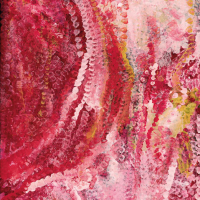65. EMILY KAME KNGWARREYE

Emily Kame Kngwarreyes place in the top echelon of Australian abstract painters is assured; her genius acclaimed for not only making us see abstract art differently, but more importantly, for making us see the landscape differently.1
Kngwarreyes paintings are tangible representations of her interconnectedness with Country Alalgura (Alhalkere), situated near Soakage Bore, Utopia, northeast of Alice Springs. For Kngwarreye, paintings were glorious manifestations of a metaphysical trinity: Country, awelye (womens law ceremonies in Anmatyerre), and self a fusion evident in her naming: kame (kam), is the seed of the wild pencil yam atnulare (Vigna lanceolata) that grows across Alalgura (Alhalkere).
The genesis of Kngwarreyes oeuvre is tied to the experiences and custodial obligations she shared with her countrywomen one grows up the land as one grows up children.2 Kngwarreyes extraordinary body of sublime and celebrated works are cultural exegeses in paint, executed with the energy of her countrys fertility and in particular, the life cycles of the pencil yam atnulare and wild potato anaroolya (also referenced as a yam).
Desert Wildness II is a striking example of the artists organic uninhibitedness;3 what has become seen as her fluidity as structure.4 Painted in the last year of the artists life following the linear works of 1994-95, and before her broad brushed final works it is stylistically closer to the output from her famous early period, wherein her paintings became looser and executed with aplomb and assurance.5 It also shares a compositional heart with several earlier period works that celebrate the natural increase of the yam, sometimes referenced as yam increase centre, where the energy of the design is concentrated at the centre, and which reappeared in her paintings in the last year of her life.
The present work is a blushing, glorious expression of the deserts lifeforce expressed in multiple shades of pink, with flashes of Alhalkere ceremonial yellow and red. With this palette, Kngwarreye arouses and animates the sacred synchronicity between yam and awelye in overlapping and distinct arcs of dotted trailing lines of yam flowers that dominate the centre, and peripheral concentrated passages of dotting in clouds and clusters.6 The resulting textural matrix, a celebratory expression of her Countrys energy its wildness bursts with custodial resonances.
Margot Neale makes the connection between Kngwarreyes lifetime of ceremonial dancing, singing, and mark-making and the compositional rhythm of her paintings, which often exhibit a circularity or more precisely, arcs akin to the way womens body marking is performed from breast to breast, arm to arm.7
Body markings are part of a metaphysical awelye thread binding all of Kngwarreyes works, across all styles and periods, illuminating continuities of purpose, presence and place, of spirit and mind; a phenomenon described as mobilizing a realm of intelligibility that produced the Aboriginal world.8 Desert Wildness IIs composition and exuberance revels in the nexus between physical and metaphysical planes.
Terry Smith describes this phenomenon succinctly as the body enacting the land wherein body becomes land, not view, not landscape, and cites the artists late works with evident arcs as exhibiting a return to this phenomenon with unmistakable clarity a woman drawing her country with her bodys reach, imprinting her sacred body markings on it, and then bringing it back into her body.9
Kngwarreyes significance was acknowledged early in her career with the prestigious Australian Artists Creative Fellowship (1992) followed by selection for the Venice Biennale (1997). Since then, her work has been consistently showcased in international exhibitions of Australian art, and her exceptional talent examined in two solo retrospective exhibitions, including Utopia: The Genius of Emily Kame Kngwarreye, which toured to Japan in 2008. In recent years, her extraordinary oeuvre has been awakening new interest overseas through a plethora of high-profile European and North American commercial exhibitions, where her making us see the landscape differently is resonating anew with international critics.
Footnotes:
1. Hers is not a view of the land, but rather its voice, Neale, M., Marks of Meaning: the Genius of Emily Kame Kngwarreye, in Utopia: The Genius of Emily Kame Kngwarreye, National Museum of Australia, ACT, 2008, p.247
2. Bell, D., Person and Place: Making Meaning of the Art of Australian Indigenous Women, Feminist Studies, vol.28, no.1, 2002, p.103
3. For an in-depth essay on the development of this aspect of her oeuvre, see Neale, M., Two Worlds: One Vision, in Emily Kngwarreye: Alhalkere Paintings from Utopia, Queensland Art Gallery, Brisbane, 1998, pp.23-31
4. Smith, T., Kngwarreye Woman Abstract Painter, in Isaacs, J., Smith, T., Ryan, J., Holt, D., & Holt, J., Emily Kngwarreye: Paintings, Craftsman House, Sydney, 1998, p.31
5. Holt, J., in Isaacs, J. et al, op. cit., p.153
6. Smith, T., Kngwarreye Woman Abstract Painter, in Isaacs, J. et al, op. cit., p.32
7. Neale, M., Two Worlds: One Vision in Utopia, op. cit., p.27
8. Ferrell, R., Dreaming, in Sacred Exchanges: Images in Global Context, Columbia University Press, New York, 2012, p.15
9. Smith, T., Kngwarreye Woman Abstract Painter, in Isaacs, J. et al, op. cit., pp.32, 37-38
Jane Raffan
Jane Raffan is an accredited valuer under the Commonwealth Governments Cultural Gifts Program. Her arts consultancy encompasses curatorial services, collection management, and a broad range of humanities-based research and writing.